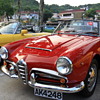Posted 11 years ago
 Streganonna
Streganonna
(13 items)
I can't identify this unusual pot and am hoping someone will recognize the maker and perhaps the age or era. The pot is about 9" tall and 11" wide. The neck is 4" wide. It is definitely pottery and not porcelain or china. The design is incised all over and then hand-painted. The lower body is brighter than the upper portion so perhaps it was in bright sunlight at some point? It appears to be a Southwestern design, but the hallmark says Santa Fe and Austria, and you can see it is signed and numbered. The impressed number mark is 14305. Perhaps a model or mold number (although I'm not sure it could have been made in a mold. The walls of the pot seem to be the same thickness throughout and there is no color inside; just bare clay.





























Check out this link:
http://www.aspireauctions.com/auction309/43737.html
This forum topic too:
http://iantiqueonline.ning.com/group/whadjafind/forum/topics/can-anyone-tell-me-what-this-is-and-what-it-s-worth?xg_source=activity
I think is a wonderful pot!
C. 1905 a 1910.
Love it!
Thanks for sharing!
Very interesting pot!
Thank you so much for all your help. I thought it was a Wilhelm Schiller & Son (Sohn) piece but simply couldn't document anything about it. It's a beauty. Could never find a connection between "Austria" and "Santa Fe."
So Austria found Santa Fe and the American market?
Very interesting.
Advances in Anthropology in 1908.
http://en.wikipedia.org/wiki/Edgar_Lee_Hewett
Discovering Native American Art.
A keeper!
The really interesting thing is that Buffalo Bill took his review to England for the jubilee year of Queen Victoria in 1887. So, I guess he brought some of the Western culture to Europe back then.
"In 1829, Wilhelm Schiller started a pottery with Freidrich Gerbing in Bodenbach. It produced very high quality terra cotta and majolica pieces. Vases, clock cases, jardinières and wall plaques were very popular, often in Classical and Renaissance motifs. This relationship lasted until 1885 when Gerbing and Stephen became an entity, and Schiller and his son went out on their own. By 1909, both companies had closed their doors. Market tastes had shifted away from Nouveau and Traditional styles to Arts & Crafts and the beginning of Art Deco. Availability of attractive products from manufacturers closer to home further reduced demand from Bohemia as flourishing potteries in Ohio and Great Britain won market share battles in the U.S.
Schiller was incredibly creative! He appears to have focused on the lucrative and ever-changing whims of the export market. His Persian line of highly ornamental stoneware is extremely beautiful, and the elaborate Majolica Rococo urns are very flamboyant. His Southwest Native vases could have been an attempt to attract the American market. His extensive production line of Art Nouveau pieces is impressive for its artistic quality and wide range of unique designs.
Collectors have let Schiller "fly under the radar screen," and only recently is there evidence of a growing worldwide interest in his works, as evidenced by increasing demand and higher prices."
http://www.go-star.com/antiquing/bohemian_pottery.htm
stunning!!!!!
Not sure if there is a Santa Fe in Austria, as mentioned in one the links. All I found was a closed restaurant with that name. Santa Fe is probably the name of the line of products designed in that style.